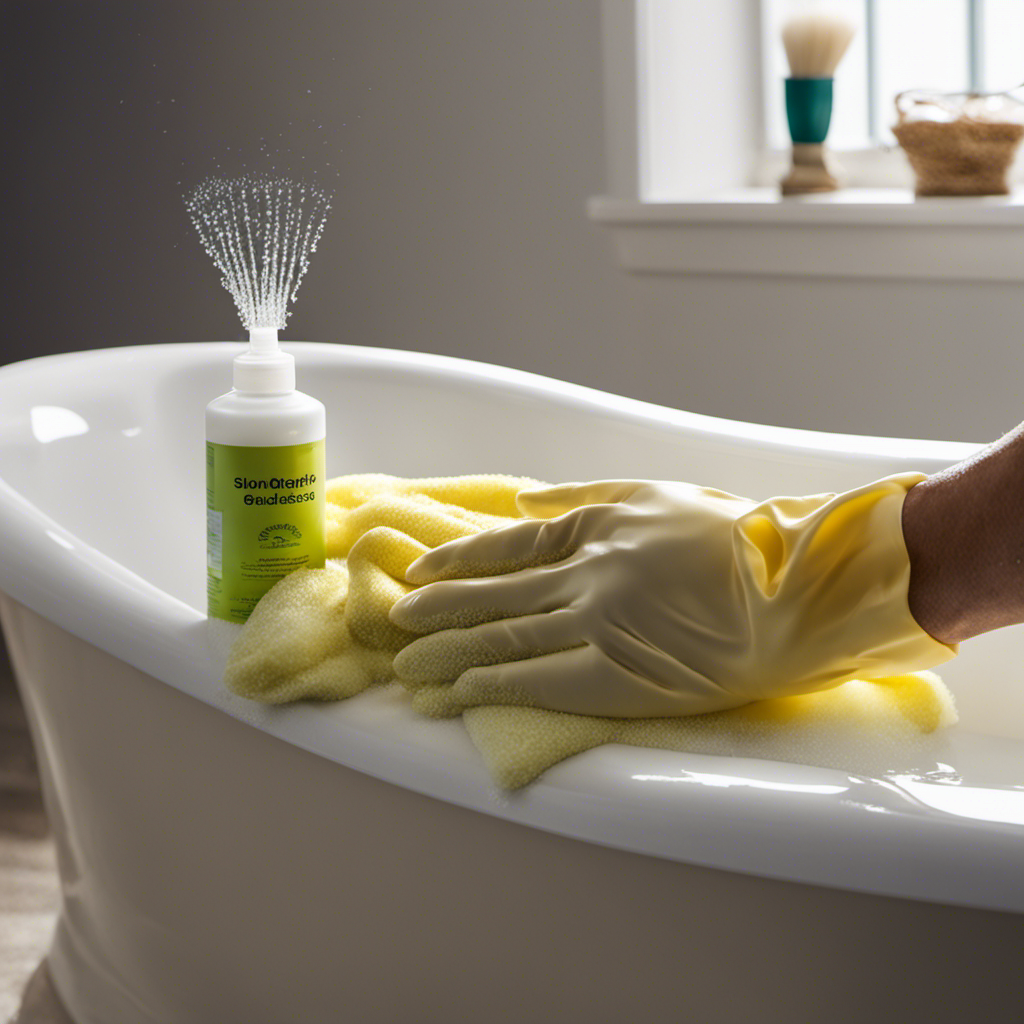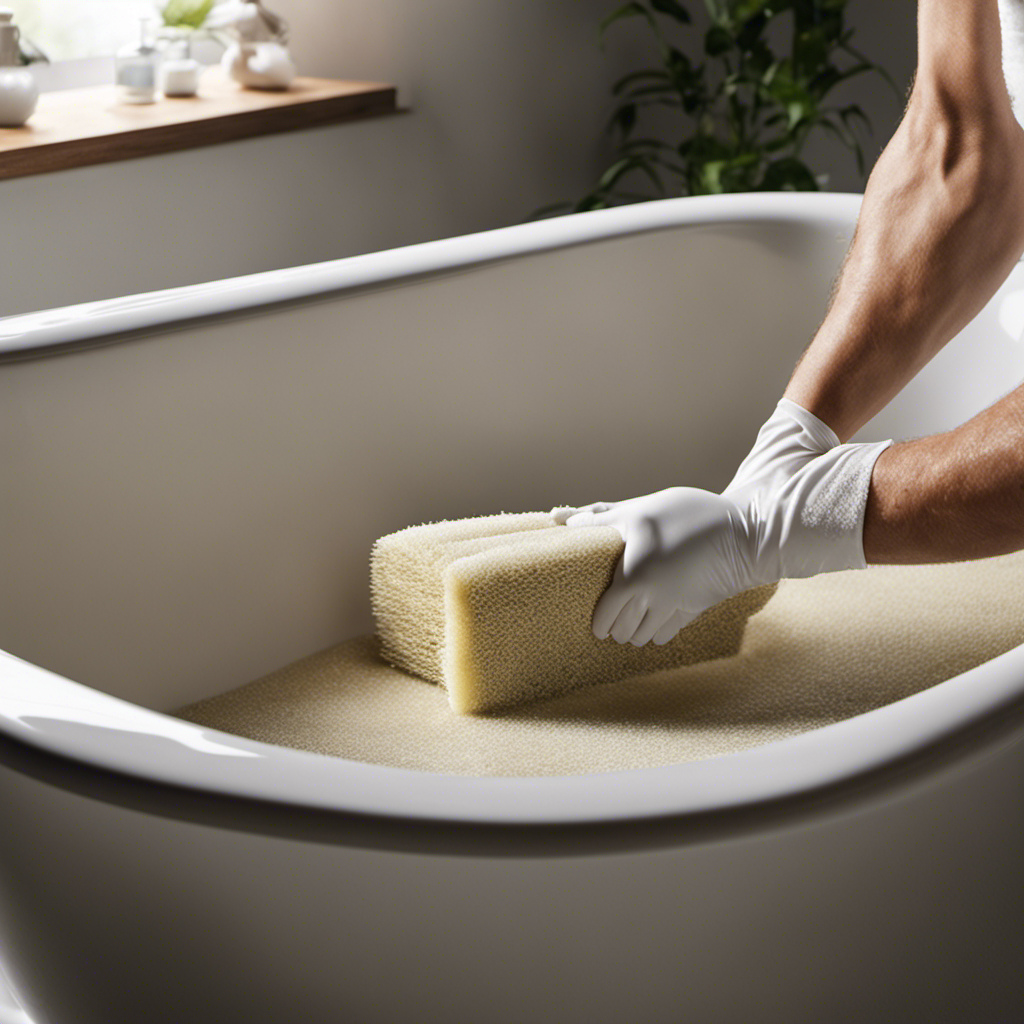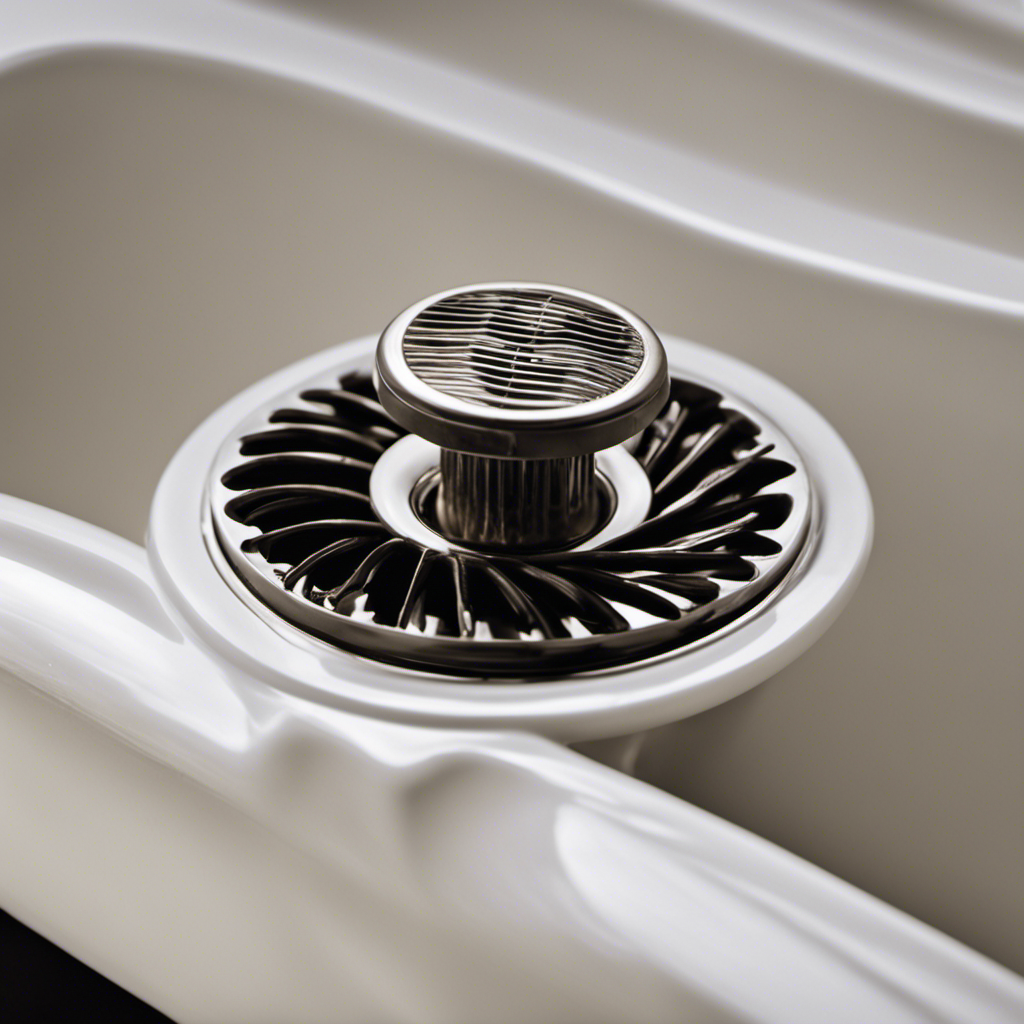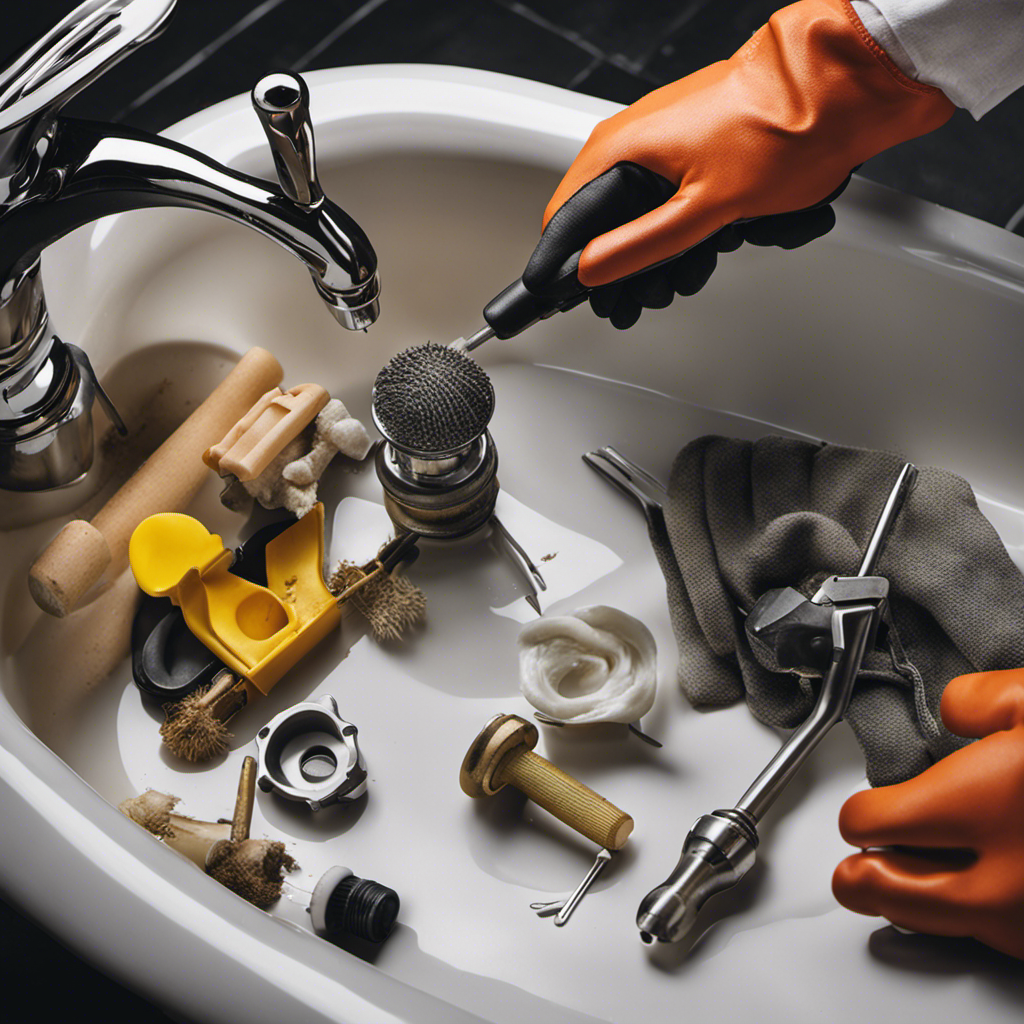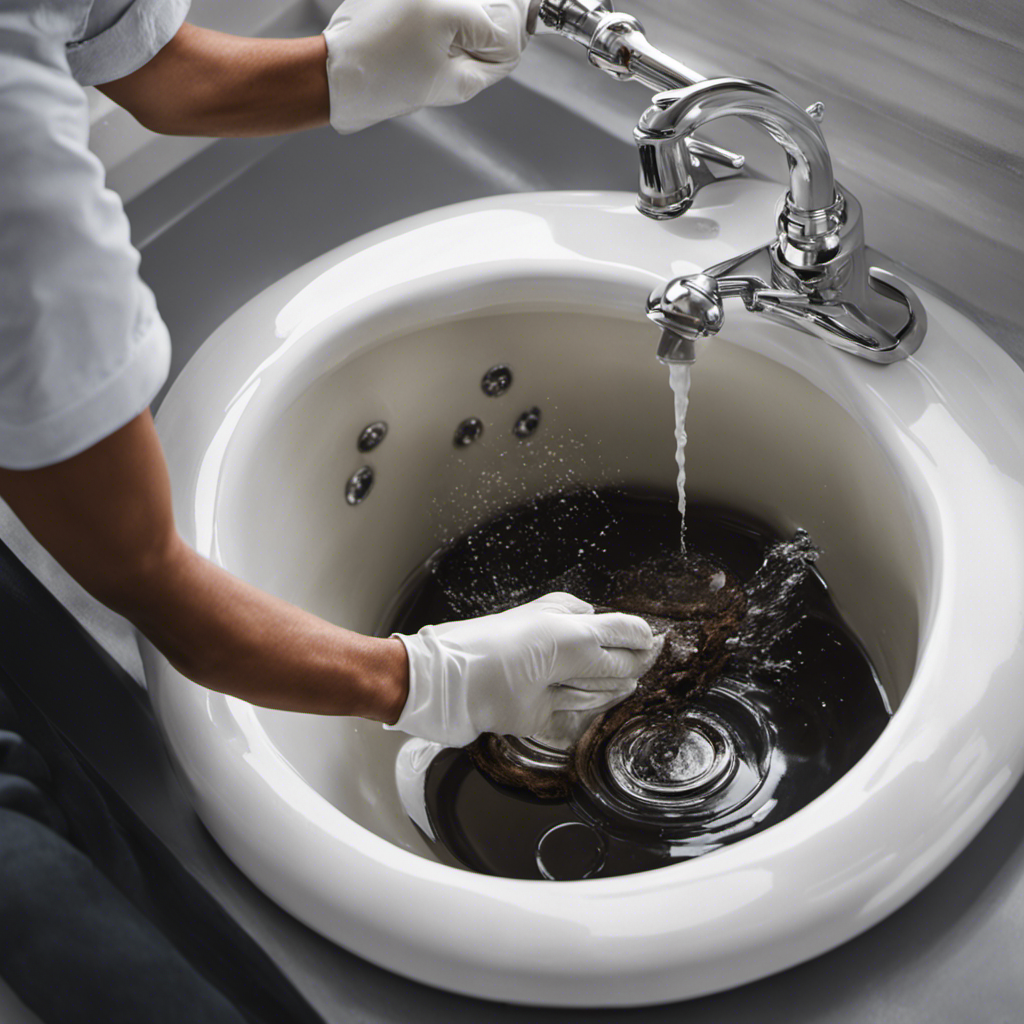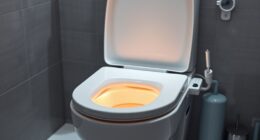I’ve struggled with mold in my bathtub before, and I know how frustrating it can be to deal with. That’s why I want to share my tried-and-true method for cleaning mold from the bathtub.
In this article, I’ll walk you through the causes of bathtub mold, the tools and supplies you’ll need, and the step-by-step process for effective mold removal.
With my detailed and methodical approach, you’ll be able to not only remove the mold but also prevent future growth.
Let’s get started!
Key Takeaways
- Inadequate ventilation and excess moisture in the bathroom lead to bathtub mold growth.
- Mold in the bathtub is unsightly and can cause damage, as well as trigger allergies, respiratory issues, and infections.
- Cleaning mold from the bathtub requires protective gear, a cleaning solution with bleach or hydrogen peroxide, a sturdy scrub brush, and a microfiber cloth.
- To prevent future mold growth, it is important to regularly inspect and maintain the bathroom, implement effective ventilation strategies, clean and dry the bathtub regularly, and monitor humidity levels.
Causes of Bathtub Mold
If you don’t properly ventilate your bathroom, you’ll likely experience mold growth in your bathtub. Mold loves moisture, and your bathroom provides the perfect environment for it to thrive.
One of the main causes of moisture in the bathroom is inadequate ventilation. When hot showers or baths are taken without proper ventilation, the steam from the water can’t escape, leading to condensation on the surfaces, including the bathtub. This excess moisture creates a breeding ground for mold.
Not only is mold unsightly and can cause damage to your bathtub, but it also poses health risks. Mold can trigger allergies, respiratory issues, and even infections in some individuals. Therefore, it is crucial to address the root causes of moisture in your bathroom to prevent mold growth in your bathtub.
Tools and Supplies Needed for Cleaning Mold
To effectively remove mold from your bathtub, you’ll need a few tools and supplies. Here is a list of items that will help you tackle the task:
-
Protective gear: Before starting the cleaning process, it’s important to protect yourself. Wear gloves, goggles, and a face mask to avoid any contact with the mold spores.
-
Cleaning solution: Choose a cleaning solution specifically designed to eliminate mold. Look for one that contains ingredients like bleach or hydrogen peroxide, as these are known to be effective against mold.
-
Scrub brush: A sturdy scrub brush with stiff bristles will help you scrub away the mold from the surface of your bathtub. Make sure to choose a brush that is suitable for use on your specific bathtub material.
-
Microfiber cloth: After scrubbing, use a microfiber cloth to wipe away any remaining mold residue. Microfiber cloths are great for trapping and removing particles without leaving streaks.
When it comes to cleaning techniques, it’s important to work in a well-ventilated area and follow the instructions on the cleaning solution carefully. If the mold problem is severe or you are unsure about how to proceed, it may be best to seek professional help to ensure the mold is completely eradicated and to prevent it from coming back.
Preparing the Bathtub for Mold Removal
Before starting, make sure you have all the necessary tools and supplies for removing mold from your bathtub. Proper bathtub maintenance is crucial for mold prevention.
To prepare the bathtub for mold removal, start by filling a bucket with warm water and adding a few drops of dish soap. Using a sponge or cloth, thoroughly clean the entire surface of the bathtub, paying special attention to any visible mold growth. Rinse the bathtub with clean water to remove any soapy residue.
Next, dry the bathtub completely using a towel or a fan to prevent moisture buildup. This step is important as mold thrives in damp environments.
With the bathtub clean and dry, you are now ready to move on to the next step: effective homemade mold cleaning solutions.
Effective Homemade Mold Cleaning Solutions
Once you have gathered all the necessary ingredients, you can easily mix up effective homemade solutions to remove mold from your bathtub. Here are four natural mold remedies that you can try:
-
Vinegar Solution: Mix equal parts of white vinegar and water in a spray bottle. Spray the solution directly onto the moldy areas and let it sit for an hour. Scrub the mold with a brush and rinse with water. Vinegar is known for its antimicrobial properties, making it an effective mold killer.
-
Hydrogen Peroxide Solution: Mix one part hydrogen peroxide with two parts water in a spray bottle. Spray the solution onto the moldy areas and leave it for 10-15 minutes. Scrub the mold with a brush and rinse thoroughly. Hydrogen peroxide is a powerful disinfectant that can effectively kill mold spores.
-
Baking Soda Paste: Make a paste by mixing baking soda with a small amount of water. Apply the paste to the moldy areas and scrub gently with a brush. Let it sit for 10 minutes before rinsing with water. Baking soda not only removes mold but also eliminates odors.
-
Tea Tree Oil Solution: Mix 2 teaspoons of tea tree oil with 2 cups of water in a spray bottle. Spray the solution onto the moldy areas and leave it overnight. The next day, scrub the mold with a brush and rinse thoroughly. Tea tree oil has antifungal properties that can effectively kill mold.
When choosing between vinegar and hydrogen peroxide, consider the severity of the mold infestation. Vinegar is more suitable for light mold growth, while hydrogen peroxide is recommended for more stubborn mold stains. Both options are effective and can be used interchangeably depending on your preference and the mold’s severity.
Step-By-Step Process for Removing Mold From Bathtub
When it comes to effective mold removal techniques, it is crucial to approach the process with a detail-oriented and methodical mindset.
First, it is important to identify the source of the mold and address any underlying issues such as leaks or excess moisture.
Next, choosing the right cleaning products and techniques is essential to ensure thorough removal of mold spores.
Lastly, implementing preventive measures such as improving ventilation and reducing humidity levels can help in preventing future mold growth.
Effective Mold Removal Techniques
To effectively remove mold from your bathtub, you’ll need a mixture of baking soda and vinegar. Here is a step-by-step guide on how to use homemade mold cleaners for professional mold removal:
-
Create a paste by mixing baking soda and water. Apply the paste to the moldy areas of your bathtub.
-
Let the paste sit for 10-15 minutes to allow it to penetrate the mold.
-
Scrub the moldy areas with a scrub brush or sponge to remove the mold.
-
Rinse the bathtub thoroughly with warm water to remove any residue.
Using this homemade mold cleaner is an effective and affordable way to tackle mold in your bathtub. However, if the mold problem is severe or persists, it is recommended to seek professional mold removal services for a more thorough and long-term solution.
Preventing Future Mold Growth
Regularly inspecting and maintaining the bathroom can help minimize the risk of future mold growth. One of the key aspects of preventing mold in the bathroom is implementing effective ventilation strategies.
Ensuring proper air circulation is crucial in keeping the bathroom dry and mold-free. Installing an exhaust fan can help remove excess moisture from the air, preventing it from settling on surfaces and creating a breeding ground for mold.
It is also important to regularly clean and dry the bathroom after use, paying close attention to areas prone to moisture, such as the shower, bathtub, and sink. Regularly inspecting and fixing any leaks or plumbing issues can further reduce the chances of mold growth.
Preventing Future Mold Growth in the Bathtub
When it comes to preventing future mold growth in the bathtub, two key points to consider are ventilation and drying techniques, as well as regular cleaning practices.
Proper ventilation, such as using exhaust fans or opening windows, helps to minimize moisture build-up, which is essential in preventing mold growth.
Additionally, implementing drying techniques, such as wiping down the bathtub after each use and ensuring it is completely dry, further reduces the chances of mold formation.
Regular cleaning practices, including using mold-inhibiting cleaners and scrubbing away any visible mold or mildew, are vital to maintaining a mold-free bathtub environment.
Ventilation and Drying Techniques
Make sure you’re using a fan or opening a window while cleaning the mold from your bathtub, as proper ventilation and drying techniques are crucial. Here are some important steps to follow to ensure effective ventilation maintenance and moisture control in your bathroom:
-
Use a fan: Turn on the exhaust fan in your bathroom before, during, and after cleaning to help remove excess moisture from the air. This will prevent mold from growing back quickly.
-
Open windows: If you don’t have a fan, open windows to allow fresh air to circulate and help dry out the bathroom. This will also help to reduce humidity levels.
-
Wipe down surfaces: After cleaning, make sure to thoroughly dry the bathtub and surrounding areas with a towel or squeegee. This will help to remove any remaining moisture and reduce the chances of mold regrowth.
-
Monitor humidity levels: Consider using a dehumidifier in your bathroom to control moisture levels. Aim for a humidity level below 50% to prevent mold growth.
Regular Cleaning Practices
To maintain a clean and healthy bathroom environment, it’s important to regularly wipe down surfaces and keep moisture levels in check. Establishing a regular cleaning schedule is key to preventing mold and mildew growth in the bathroom.
I recommend setting aside specific days each week to thoroughly clean and disinfect all surfaces, including the bathtub, tiles, and sink. Make sure to use a mold-resistant shower curtain to minimize the chances of mold developing in the bathroom. This type of curtain is designed to resist moisture and inhibit the growth of mold and mildew.
Additionally, be sure to properly dry the bathroom after each use to prevent excess moisture from lingering. Implementing these practices will help keep your bathroom clean, fresh, and mold-free.
Conclusion
In conclusion, tackling mold in your bathtub may seem like a daunting task, but with the right tools and techniques, it can be a breeze.
By following the step-by-step process outlined in this article, you can effectively remove mold and prevent future growth.
Remember, cleanliness is key to enjoying a pleasant bathing experience. So, embrace the opportunity to transform your bathtub into a mold-free oasis and indulge in the euphoria of a pristine bathing environment.
